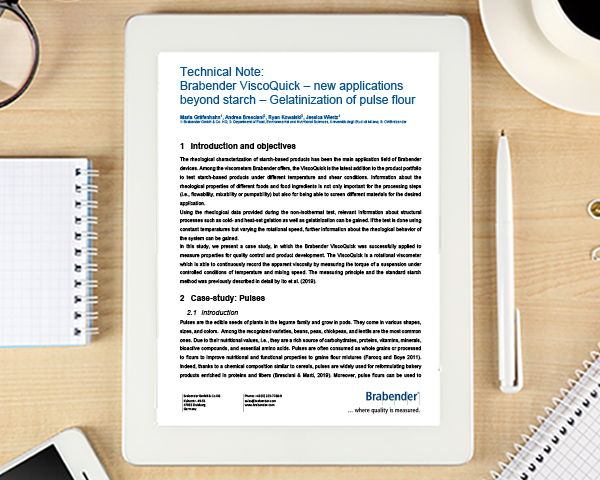Study: Analysis of pulse flour gelatinization
- Like
- Digg
- Del
- Tumblr
- VKontakte
- Buffer
- Love This
- Odnoklassniki
- Meneame
- Blogger
- Amazon
- Yahoo Mail
- Gmail
- AOL
- Newsvine
- HackerNews
- Evernote
- MySpace
- Mail.ru
- Viadeo
- Line
- Comments
- Yummly
- SMS
- Viber
- Telegram
- Subscribe
- Skype
- Facebook Messenger
- Kakao
- LiveJournal
- Yammer
- Edgar
- Fintel
- Mix
- Instapaper
- Copy Link
Posted: 13 April 2021 | Brabender | No comments yet
In this case study, the gelatinization behavior of different pulse flours was determined with the Brabender ViscoQuick universal viscometer.
Pulses are often consumed as whole grains or processed to flours to improve nutritional and functional properties to grains flour mixtures. Thanks to a chemical composition similar to cereals, pulses are widely used for reformulating bakery products enriched in proteins and fibers. Moreover, pulse flours can be used to produce soups, pasta, noodles and even meat analogues. Consequently, relevant functional properties of pulse flour include water solubility, water binding or absorption, thickening, and gelling properties. These properties depend among others on the amount of protein, starch, and fiber present in the flour mixture and on their physicochemical properties.
In this study, the starch gelatinization behaviour of chickpea, faba, red lentil and yellow lentil flour samples was analyzed and compared.
For the measurement, the Brabender ViscoQuick was used, which has proven reliable for analyzing the properties of starch and starch-based products as well as for testing the viscosity of various viscous and pasty masses.
Related content from this organisation
Related topics
Food Safety, Health & Nutrition, Ingredients, Processing, Product Development, Quality analysis & quality control (QA/QC)








